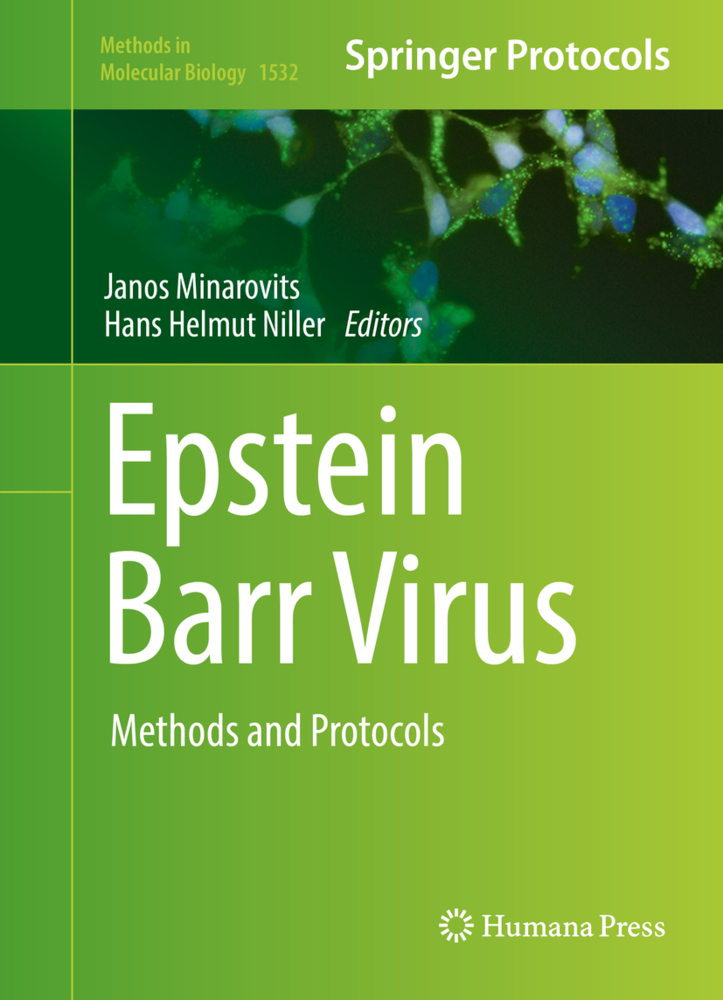
Zustellung: Mo, 12.05. - Do, 15.05.
Versand in 1-2 Wochen
VersandkostenfreiBestellen & in Filiale abholen:
This volume explores data from the applications of molecular biological methods and the applications of recent immunological and cytogenetic methods in Epstein-Barr Virus (EBV) that will offer readers possible new solutions to the unresolved problems in the EBV field. Chapters in this book cover topics such as: viral life cycle, latency, EBV-associated diseases and EBV diagnostics; in vitro methods including organotypic cultures for the analysis of EBV-epithelial cell interactions; identification of the interacting viral and cellular proteins using affinity purification-mass spectrometry methods; 3D telomere FISH; transcription analysis using high-throughput RNA sequencing, qPCR and nuclear run-on assay; analysis of viral and cellular microRNAs; isolation and characterization of exosomes and the assessment of their function; characterization of the viral genome by terminal repeat analysis and sequencing; the use of chromatin immunoprecipitation coupled sequencing (ChIP-Seq) for theanalysis of Zta-DNA interactions; epigenetic analysis by bisulfite sequencing and ChIP; novel in vivo models for the study of EBV infection; and how immunological, virological, tissue culture and molecular methods can be combined to yield Good Manufacturing Practice-compliant EBV-specific T cells for the immunotherapy of EBV-associated post-transplant lymphoproliferative diseases (PTLD). Written in the highly successful Methods in Molecular Biology series format, chapters include introductions to their respective topics, lists of the necessary materials and reagents, step-by-step, readily reproducible laboratory protocols, and tips on troubleshooting and avoiding known pitfalls.
Cutting-edge and comprehensive, Epstein Barr-Virus: Methods and Protocols is a valuable resource for anyone who is interested in this fascinating and evolving field.
Inhaltsverzeichnis
Current Trends and Alternative Scenarios in EBV Research. - Epstein-Barr Virus: Clinical Diagnostics. - Establishment of EBV-Infected Lymphoblastoid Cell Lines. - Generation and Infection of Organotypic Cultures with Epstein-Barr Virus. - Affinity Purification-Mass Spectroscopy Methods for Identifying Epstein-Barr Virus-Host Interactions. - The Use of 3D Telomere FISH for the Characterization of the Nuclear Architecture in EBV-Positive Hodgkin s Lymphoma. - Analysis of EBV Transcription Using High-Throughput RNA Sequencing. - Analysis of Viral Promoter Usage in EBV-Infected Cell Lines: A Comparison of qPCR following Conventional RNA Isolation and Nuclear Run-On Assay. - Analysis of Viral and Cellular MicroRNAs in EBV Infected Cells. - Isolation and Characterization of Exosomes Released by EBV Immortalized Cells. - Functional Analysis of Exosomes Derived from EBV-Infected Cells. - Terminal Repeat Analysis of EBV Genomes. - Characterization of EBVPromoters and Coding Regions by Sequencing PCR-Amplified DNA Fragments. - The Use of Chromatin Precipitation Coupled to DNA Sequencing (ChIP-Seq) for the Analysis of Zta Binding to the Human and EBV Genome. - Analysis of Viral Epigenotypes Using Bisulfite Sequencing: A Detailed Protocol for the Crucial Bisulfite Modification and PCR Amplification Steps. - Analysis of Viral Epigenotypes using Chromatin Immunoprecipitation. - Mice with Reconstituted Human Immune System Components as a Tool to Study Immune Cell Interactions in EBV Infection. - Generation and Analysis of Humanized Mouse Model of EBV Infection. - EBV-Directed T Cell Therapeutics for EBV-Associated Lymphomas.
Produktdetails
Erscheinungsdatum
22. November 2016
Sprache
englisch
Auflage
1st ed. 2017
Seitenanzahl
284
Reihe
Methods in Molecular Biology
Herausgegeben von
Janos Minarovits, Hans Helmut Niller
Verlag/Hersteller
Produktart
gebunden
Abbildungen
XIV, 269 p. 22 illus., 21 illus. in color.
Gewicht
736 g
Größe (L/B/H)
260/183/21 mm
Sonstiges
HC runder Rücken kaschiert
ISBN
9781493966530
Entdecken Sie mehr
Pressestimmen
This is an excellent book with a good number of color illustrations providing recent immunological and cytogenetic methods and protocols aimed at finding easy solutions to unresolved problems in the field of Epstein Barr virus. The book is appropriate for students and scientists interested in Epstein Barr Virus (EBV) and EBV diagnostics. The book has high quality color illustrations to promote easy understanding of this complex subject. (Omer Iqbal, Doody' s Book Reviews, April, 2017)
Bewertungen
0 Bewertungen
Es wurden noch keine Bewertungen abgegeben. Schreiben Sie die erste Bewertung zu "Epstein Barr Virus" und helfen Sie damit anderen bei der Kaufentscheidung.










